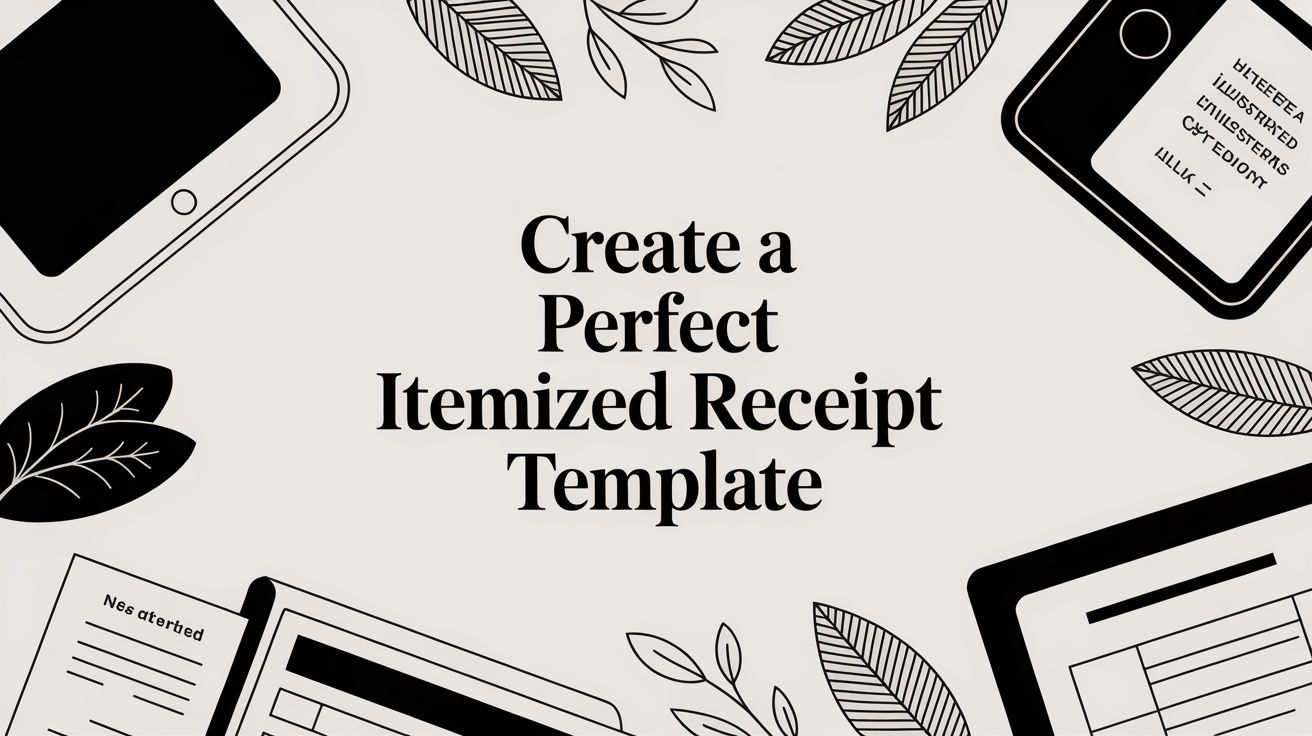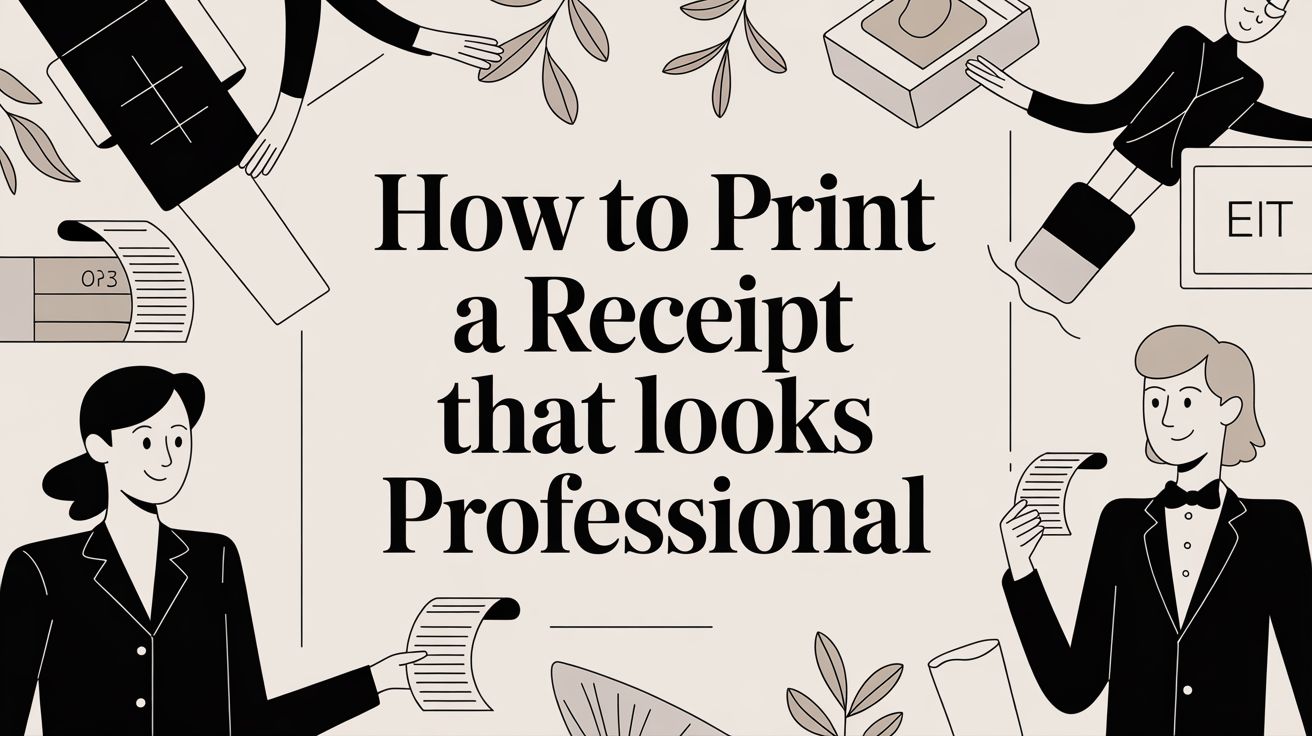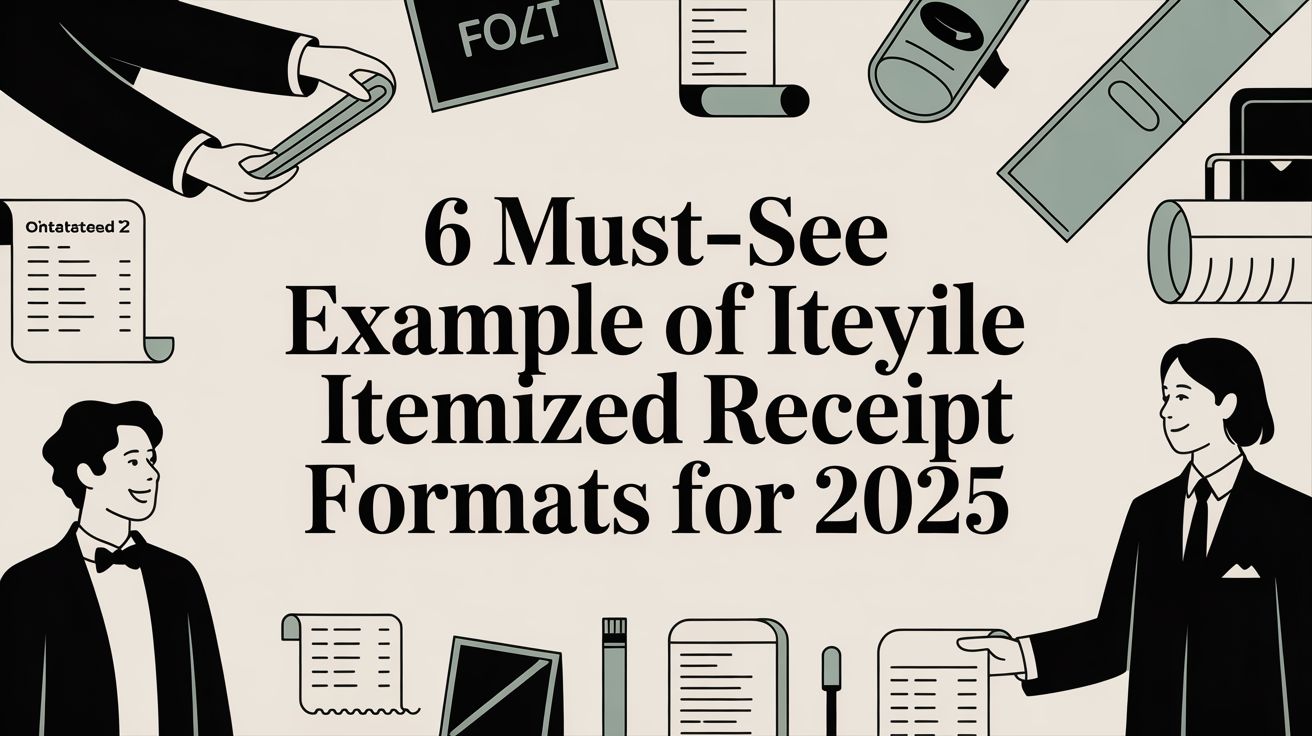
6 Must-See Example of Itemized Receipt Formats for 2025
In a world of quick taps and digital payments, the humble itemized receipt remains a cornerstone of financial clarity and trust. For small business owners, freelancers, and managers, a well-structured receipt is far more than just proof of purchase. It's a critical tool for accurate bookkeeping, a necessary document for tax deductions, and a key touchpoint in building customer confidence. A poorly designed receipt can cause confusion and disputes, while a great one streamlines everything from expense reporting to inventory management.
This guide is designed to be your go-to resource for understanding and creating effective receipts. We will break down several distinct example of itemized receipt types from various industries, including retail, dining, e-commerce, and professional services. For each example, we'll provide a detailed analysis, highlighting crucial fields, explaining calculations, and offering actionable takeaways.
You'll learn not just what to include, but why it matters for compliance and customer satisfaction. By the end, you'll see how a professional receipt strengthens your business operations and have the tools to create your own perfect versions with downloadable templates.
1. Basic Retail Store Itemized Receipt
The basic retail store receipt is the most recognizable example of itemized receipt format you'll encounter. It serves as a fundamental proof of purchase for everyday transactions at places like grocery stores, clothing retailers, and electronics shops. Its primary function is to provide a detailed breakdown of a transaction, listing each item, its quantity, and its price.
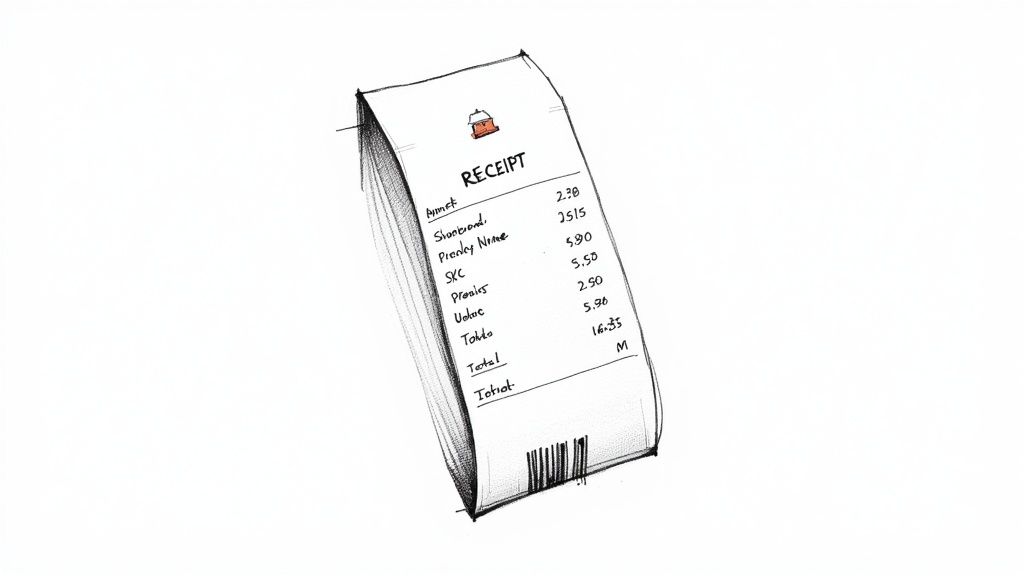
This format is essential for both the consumer and the business. For customers, it confirms what they paid for, helps with returns or warranty claims, and is crucial for personal budgeting. For businesses, it creates a transparent record of the sale, aids in inventory management, and ensures accurate financial accounting.
Strategic Analysis of the Example
The effectiveness of a retail receipt lies in its clarity and structure. Let's break down the key components of the example above:
- Business Information: The store name, address, and phone number are clearly displayed at the top. This is vital for returns, customer service inquiries, and brand recognition.
- Transaction Details: Date, time, and receipt number (e.g., #12345) provide a unique identifier for each sale. This information is critical for tracking transactions and resolving any discrepancies.
- Itemized List: Each product (e.g., "Organic Bananas," "Whole Milk") is listed on a separate line. The format
QTY x Price = Line Total(e.g.,1 @ $4.99) is standard and easy to understand. - Financial Summary: The receipt clearly separates the Subtotal (total cost of items), Sales Tax (calculated on the subtotal), and the Total (the final amount paid). This transparency is a legal requirement in many regions.
- Payment Information: Details like the payment method (e.g., VISA) and the amount tendered/change due confirm the completion of the transaction.
Key Takeaway: The power of a standard retail receipt is its universal readability. A customer can quickly scan it to verify charges, and a bookkeeper can easily process it for accounting purposes. This format minimizes confusion and builds trust.
Actionable Tips for Your Business
Whether you're creating receipts for your own store or just need to understand them better, here are some actionable tips:
- Prioritize Clarity: Use a clean font and logical layout. Don't crowd information. The goal is to make the receipt as easy to read as possible.
- Ensure Compliance: Include all legally required information, such as your business name, address, and tax details. This protects both you and your customer.
- Add Value: Consider adding a small thank you message, a coupon for a future purchase, or a link to your store’s social media. This turns a simple receipt into a marketing tool.
By mastering this fundamental format, you ensure your transactions are documented accurately and professionally. You can easily create a similar document with a customizable template. To generate your own, check out this Generic POS Receipt template for a great starting point.
2. Restaurant/Dining Itemized Receipt
The restaurant receipt is a specialized example of itemized receipt tailored for the food service industry. You'll see this format at fine dining establishments, coffee shops like Starbucks, and fast-casual spots. It meticulously lists each dish and beverage ordered, providing clarity for customers and essential data for the business.
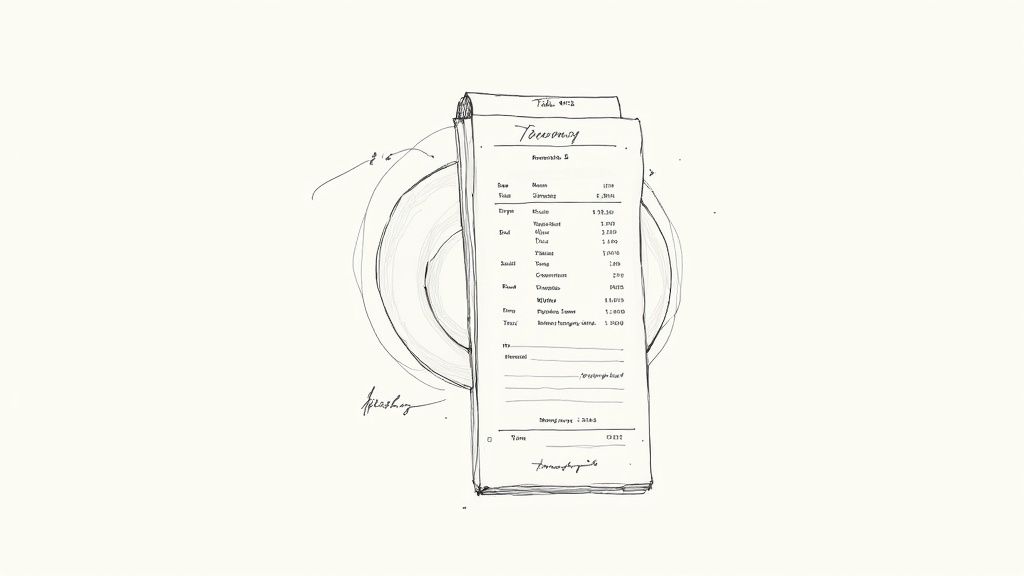
This format is critical for managing complex orders, splitting bills among guests, and handling gratuities. For customers, it confirms order accuracy and justifies the final bill. For restaurants, it streamlines the payment process, aids in tracking food sales for inventory management, and provides a clear record for accounting and tax purposes.
Strategic Analysis of the Example
A restaurant receipt's effectiveness depends on its ability to clearly communicate order details and payment calculations. Let's analyze the key components of the example provided:
- Header Information: The restaurant's name and location are prominently displayed, along with the server's name and table number. This helps associate the transaction with a specific service experience.
- Detailed Order List: Each item, from the "Cheeseburger" to the "Iced Tea," is listed individually with its price. This allows diners to easily verify their order and understand the cost of each component.
- Financial Breakdown: The receipt clearly separates the Subtotal (cost of food and drinks), Tax, and Total. Crucially, it also includes a dedicated section for Gratuity (or tip), which is a unique feature of dining receipts.
- Gratuity Suggestions: Many modern restaurant receipts include suggested tip percentages (e.g., 18%, 20%, 25%). This simplifies the calculation for the customer and can encourage fair tipping for the service staff.
- Payment and Signature Line: The bottom section confirms the payment method and provides a space for the customer to write in the tip amount, calculate the final total, and sign to authorize the charge.
Key Takeaway: The restaurant receipt is designed for transparency and action. It not only documents the sale but also facilitates the social and financial transaction of tipping, making it a crucial tool for both customer satisfaction and employee compensation.
Actionable Tips for Your Business
Whether you run a cafe or a full-service restaurant, a well-designed receipt can enhance the customer experience and streamline your operations.
- Itemize Everything: List every single menu item, including modifiers like "no onions" or "extra cheese," even if they don't have a cost. This level of detail reduces confusion and disputes.
- Suggest Gratuity: Add suggested tip percentages to your receipts. This simple addition is a helpful customer service feature and has been shown to increase average tip amounts for your staff.
- Incorporate a Feedback Request: Use the bottom of the receipt to add a link to a review site or a QR code for a customer feedback survey. This turns a simple transaction record into a valuable marketing and improvement tool.
By implementing these features, you ensure every transaction is clear, professional, and contributes positively to your business. If you want to create a receipt with this level of detail, you can start with a professional template. To see a popular format in action, check out this Starbucks Receipt template for inspiration.
3. E-commerce/Online Purchase Itemized Receipt
In the digital age, the e-commerce receipt is a vital example of an itemized receipt sent directly to a customer's email. This digital document serves as the primary proof of purchase for online transactions from retailers like Amazon, Shopify stores, or Etsy sellers. It provides a comprehensive record of the sale, detailing products, costs, shipping information, and payment confirmation.
This digital format is indispensable for both the online shopper and the vendor. For customers, it’s an immediate confirmation of their order, a reference for tracking shipments, and the necessary document for initiating returns or exchanges. For e-commerce businesses, it’s an automated, efficient way to confirm transactions, reduce customer service inquiries, and maintain precise digital records for accounting and inventory.
Strategic Analysis of the Example
The power of an e-commerce receipt is its depth of information and immediate delivery. Let's analyze the key elements in the example above:
- Order Confirmation & Business Branding: The top of the receipt clearly states "Your Order is Confirmed" and features the company logo. This immediately reassures the customer and reinforces brand identity.
- Detailed Order Summary: The receipt itemizes each product with its name, quantity, and price. Unlike many physical receipts, it often includes product images, which helps reduce errors and improves the customer experience.
- Comprehensive Financial Breakdown: It clearly separates the Subtotal, Shipping costs, Taxes, and any Discounts applied. This level of transparency is crucial for building trust in online transactions.
- Shipping & Billing Information: The receipt includes both the "Shipping to" and "Billed to" addresses. This allows customers to quickly verify that their order is going to the correct location, preventing costly shipping mistakes.
- Payment & Order Details: Key identifiers like the Order Number (e.g., #1001) and payment method are included for easy reference in any future communication with customer support.
Key Takeaway: The e-commerce receipt is more than just a transaction record; it's a critical communication tool. Its detailed, well-organized format provides customers with all the information they need in one place, reducing anxiety and follow-up questions.
Actionable Tips for Your Business
If you run an online store or want to manage your digital purchases better, here are some actionable tips:
- Automate and Brand: Use your e-commerce platform (like Shopify or WooCommerce) to automatically send branded, detailed receipts. A professional-looking receipt builds customer confidence.
- Include All Key Details: Ensure your receipts list the order number, item details (with images if possible), a full cost breakdown, and both shipping and billing addresses to minimize confusion.
- Add Tracking and Support Links: Enhance the customer experience by embedding a shipping tracking link and clear contact information for your support team directly within the email receipt.
By optimizing your digital receipts, you can streamline your post-purchase process and improve customer satisfaction. To create a professional-looking digital receipt, you can use a customizable tool. Check out this Generic Email Receipt template to get started.
4. Medical/Healthcare Itemized Receipt
A medical or healthcare receipt is a highly specialized example of itemized receipt provided by clinics, hospitals, pharmacies, and other healthcare providers. It documents the specific services, procedures, medications, and supplies a patient received, along with their associated costs. This detailed breakdown is essential for navigating the complexities of health insurance and personal finance.
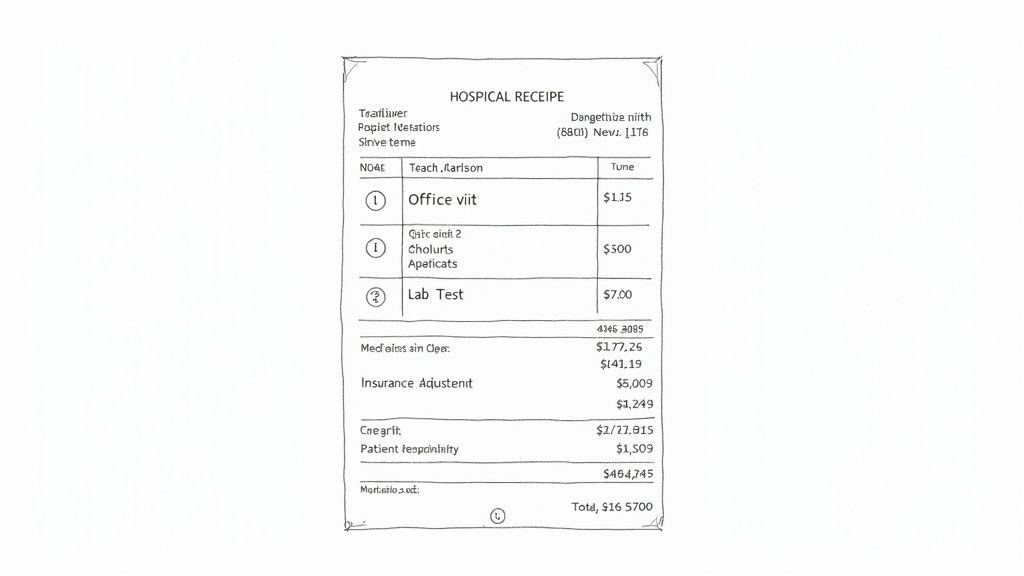
Unlike a simple summary bill, the itemized version is crucial for patients to verify charges, for insurance companies to process claims accurately, and for individuals to claim medical expenses on their taxes. For providers, it ensures transparent billing practices and compliance with regulations like HIPAA, which governs patient privacy.
Strategic Analysis of the Example
The power of a medical receipt comes from its granular detail, which allows for thorough auditing by all parties. Let's analyze the key components of the example above:
- Provider and Patient Information: The top of the receipt clearly lists the healthcare provider's details and the patient's information, including a unique patient ID. This ensures the bill is correctly assigned and routed.
- Service and Billing Codes: Each service or procedure (e.g., "Office Visit," "Lab Test - CBC") is listed with specific medical codes like CPT (Current Procedural Terminology) codes. These universal codes are vital for insurance companies to understand and process the services rendered.
- Detailed Cost Breakdown: The receipt separates the total charge for each service, the amount covered or adjusted by insurance, and the final Patient Responsibility. This clarity is non-negotiable for understanding what is owed and why.
- Financial Summary: A clear summary shows the Total Billed Amount, Insurance Paid, Adjustments, and the final Balance Due. This helps patients reconcile the bill with their Explanation of Benefits (EOB) from their insurer.
- Transaction Information: The date of service, invoice number, and payment due date are prominently displayed, providing a clear timeline and reference for payment and record-keeping.
Key Takeaway: The strategic value of a medical itemized receipt is its role as an auditable, transparent record. It empowers patients to question incorrect charges and ensures providers maintain compliant and clear billing systems, which is fundamental for trust in the healthcare system.
Actionable Tips for Your Business
For healthcare providers creating these documents or patients trying to understand them, these tips are essential:
- Use Standardized Codes: Always include standard medical billing codes (like CPT or ICD-10) for every service. This is the language insurers speak and is necessary for prompt payment.
- Review and Cross-Reference: As a patient, always compare your itemized receipt with the Explanation of Benefits (EOB) from your insurer. Question any discrepancies immediately with the provider’s billing department.
- Maintain Meticulous Records: Keep all medical receipts and EOBs organized. This documentation is invaluable for tax deductions, health savings account (HSA) reimbursements, and resolving any future billing disputes.
By understanding the structure of a medical receipt, both providers and patients can ensure financial accuracy and transparency in healthcare transactions.
5. Service Industry Itemized Receipt
The service industry receipt is a critical example of itemized receipt that documents labor and materials rather than just tangible products. It is used by businesses like auto repair shops, salons, and home service contractors to provide a transparent breakdown of the work performed, ensuring customers understand exactly what they are paying for. Its primary function is to detail services rendered, parts used, and labor costs.
This format builds trust and justifies the total cost, which can often be more complex than a simple retail transaction. For customers, it offers a clear record for warranty purposes and helps in comparing quotes. For service businesses, it serves as a professional invoice, a record of work done, and a vital tool for managing parts inventory and labor allocation.
Strategic Analysis of the Example
The strength of a service receipt lies in its detailed and clear separation of charges. Let's break down the key components common in this format:
- Customer & Service Details: Includes the customer's name and contact information, plus details about the item being serviced (e.g., vehicle VIN, appliance model number). This is essential for record-keeping and follow-up.
- Itemized Services & Parts: The receipt distinctly separates charges into two categories. Labor is often listed with a description of the work and the hours billed, while Parts are itemized with individual costs, similar to a retail receipt.
- Cost Breakdown: The format clearly shows how different charges contribute to the final bill. It lists the subtotal for parts, the subtotal for labor, any shop fees or environmental charges, and applicable taxes.
- Authorization and Notes: Many service receipts include a section for customer authorization, confirming they agreed to the work. There may also be notes from the technician detailing observations or recommendations for future service.
- Financial Summary: Like other receipts, it concludes with a clear Subtotal, Tax, and Total Due. It also confirms the payment method and amount paid.
Key Takeaway: A service industry receipt's power comes from its transparency in separating labor from materials. This clear itemization demystifies the final cost, justifies the charges, and helps prevent disputes by showing the value provided through both expertise and physical parts.
Actionable Tips for Your Business
Whether you're an auto mechanic or a freelance contractor, a well-structured service receipt is non-negotiable. Here are some actionable tips:
- Separate Labor and Parts: Always list labor charges and parts on separate lines or in distinct sections. Specify the hourly rate and number of hours for labor to provide maximum clarity.
- Be Descriptive: Instead of a vague "Repair Service," write "Diagnose and Replace Alternator (2.5 hours)." For parts, include part numbers if possible. This level of detail builds credibility.
- Include Recommendations: Use a notes section to recommend future services (e.g., "Brake pads show 30% wear, recommend replacement in 5,000 miles"). This adds value and encourages repeat business.
By creating a detailed and transparent service receipt, you document the transaction professionally and build lasting customer trust.
6. Invoice-Style Business Itemized Receipt
An invoice-style receipt is a more formal example of itemized receipt commonly used in business-to-business (B2B) transactions, freelancing, and service-based industries. Unlike a simple retail receipt, this format acts as both a detailed bill and a proof of payment, containing comprehensive information necessary for corporate accounting and tax purposes.
This document is crucial for professionals like consultants, software developers, and marketing agencies. For the service provider, it formalizes the request for payment and creates an official record of revenue. For the client, it provides a detailed breakdown of services rendered or products sold, which is essential for authorizing payments and claiming business expenses.
Strategic Analysis of the Example
The strength of an invoice-style receipt is its formality and comprehensive detail, which is vital for clear business-to-business communication. Let's analyze the critical components:
- Business Information: Both the sender's and the client's full business name, address, and contact details are prominently displayed. Including identifiers like Tax ID or business registration numbers adds a layer of professional legitimacy.
- Transaction Details: A unique invoice number (e.g., #INV-0078) is essential for tracking and referencing the transaction in both parties' accounting systems. The invoice date and payment due date are also clearly stated.
- Itemized List: This is the core of the document. Each service or product is a separate line item with a detailed description (e.g., "Project Management Hours," "Software License"). The format
Description | Quantity | Unit Price | Line Totalprovides complete transparency. - Financial Summary: The receipt clearly distinguishes the Subtotal, any applicable Taxes (like VAT or GST), and the final Total Amount Due. This breakdown is non-negotiable for accurate financial reporting and tax compliance.
- Payment Terms: This section explicitly states the conditions for payment, such as "Net 30" (due in 30 days), and lists accepted payment methods. This clarity helps prevent late payments and disputes.
Key Takeaway: The invoice-style receipt is a legally and financially robust document. Its detailed, structured format removes ambiguity, facilitates prompt payment, and ensures both businesses have the necessary records for accounting and audits.
Actionable Tips for Your Business
If your business operates in a B2B or service-based model, mastering the invoice receipt is fundamental. Here are some actionable tips:
- Standardize Your Format: Use a consistent template for all invoices. This projects professionalism and makes it easier for clients to process your payments.
- Include Clear Payment Terms: Don't leave payment deadlines open to interpretation. Clearly state terms like "Due upon receipt" or "Net 30" to manage your cash flow effectively.
- Number Invoices Sequentially: A sequential numbering system (e.g., 2024-001, 2024-002) is critical for maintaining an organized audit trail and preventing duplicate records.
- Be Prompt and Detailed: Send invoices immediately after delivering a service or product. Ensure every line item is clearly described to avoid client questions and payment delays.
By implementing a professional invoice-style receipt, you streamline your billing process and strengthen your business relationships. You can create a polished document using a dedicated tool. To get started, you can generate a professional Invoice-Style Business Itemized Receipt with an easy-to-use template.
Itemized Receipts — 6-Example Comparison
| Receipt Type | 🔄 Implementation complexity | ⚡ Resource requirements | 📊 Expected outcomes | Ideal use cases | ⭐ Advantages / 💡 Tips |
|---|---|---|---|---|---|
| Basic Retail Store Itemized Receipt | Low — standardized POS templates, minimal customization | Low — POS terminal, thermal printer, paper stock | Clear proof of purchase; supports returns and budgeting | Brick-and-mortar grocery, clothing, convenience stores | ⭐ Familiar & easy to read; 💡 photograph thermal receipts before they fade |
| Restaurant/Dining Itemized Receipt | Low–Medium — POS with modifiers, tip line, server/table fields | Medium — restaurant POS, printed checks or email receipts | Itemized meal charges, tip guidance, facilitates bill splitting | Restaurants, cafes, bars, group dining | ⭐ Transparent meal breakdown; 💡 verify service charges to avoid duplicates |
| E-commerce/Online Purchase Itemized Receipt | Medium — integrates orders, payments, shipping, tax calc. | Medium — e‑commerce platform, email/PDF generation, tracking APIs | Detailed digital record with tracking and easy returns; searchable archive | Online retailers, marketplaces, DTC stores | ⭐ Persistent, paperless records; 💡 save PDFs and use email filters for organization |
| Medical/Healthcare Itemized Receipt | High — requires CPT/ICD coding, insurance adjudication, privacy controls | High — medical billing systems, EHR integration, coding staff, secure storage | Detailed service/charge breakdown for claims, tax and reimbursement purposes | Hospitals, clinics, pharmacies, specialty practices | ⭐ Essential for insurance claims & HSA/FSA; 💡 always request itemized receipts and cross-check EOBs |
| Service Industry Itemized Receipt | Medium — must detail labor, parts, rates, warranties | Medium — scheduling/payment tools, parts inventory, technician records | Transparent labor vs. parts costs; supports warranties and disputes | Auto repair, salons, HVAC/plumbing, appliance/electronics repair | ⭐ Documents work and materials; 💡 get written estimates and separate parts vs labor line items |
| Invoice-Style Business Itemized Receipt | High — formal invoicing, payment terms, tax IDs, approval workflows | High — accounting/invoicing software, AR processes, legal/compliance inputs | Professional billing, payment tracking, audit-ready financial records | B2B services, consultants, freelancers, suppliers | ⭐ Improves cash flow & compliance; 💡 standardize invoices and use accounting software for automation |
Turn These Examples Into Your Own Professional Receipts
Throughout this guide, we have journeyed through a diverse range of itemized receipt examples, from bustling retail stores and cozy cafes to detailed freelancer invoices and complex medical billing. Each example of an itemized receipt serves as more than just a proof of purchase; it is a vital communication tool, a legal document, and a cornerstone of sound financial management for any business. The strategic breakdown of each receipt revealed a common thread: clarity, accuracy, and completeness are non-negotiable.
Mastering the art of the itemized receipt is about embracing these principles. It's about ensuring every charge is transparent, every calculation is correct, and every piece of essential information is present. This attention to detail builds customer trust, streamlines your accounting processes, and protects your business during audits or disputes. The power lies in turning these foundational concepts into practical application.
Key Takeaways for Immediate Action
Let's distill the core strategies from our analysis into actionable steps you can implement today:
- Categorize Everything: As seen in the restaurant and retail examples, grouping items (e.g., "Appetizers," "Apparel") makes the receipt instantly understandable and helps customers quickly verify their purchase.
- Itemize Taxes and Fees Separately: Never bundle taxes or service fees into the subtotal. Listing them as distinct line items, as demonstrated in our travel and e-commerce receipts, is crucial for transparency and legal compliance.
- Use Clear and Simple Language: Avoid industry jargon or cryptic abbreviations. The goal is for anyone to understand the receipt at a glance, a principle that is especially important in service-based invoices and medical receipts.
- Incorporate Your Brand: A receipt is a final touchpoint with your customer. Adding your logo, contact information, and a consistent color scheme reinforces your brand identity and professionalism.
Why This Matters for Your Business Growth
A well-crafted itemized receipt does more than just close a transaction. It reflects the integrity and professionalism of your entire operation. For small business owners and freelancers, it legitimizes your services and simplifies tax preparation. For managers in retail or food service, it minimizes customer disputes and empowers staff to handle transactions confidently.
Ultimately, by adopting these best practices, you are investing in your business's reputation and operational efficiency. Each receipt you issue becomes a testament to your commitment to transparency and quality service. You're not just providing a piece of paper; you're delivering peace of mind and building a foundation for lasting customer relationships. This simple document is a powerful tool in your business arsenal, capable of enhancing credibility and streamlining the complexities of financial tracking.
Ready to move from theory to practice? Stop wrestling with spreadsheets or generic templates. ReceiptMake offers a library of 100+ professionally designed templates inspired by the examples in this article. Generate a perfect, customized, and free itemized receipt in seconds at ReceiptMake.
